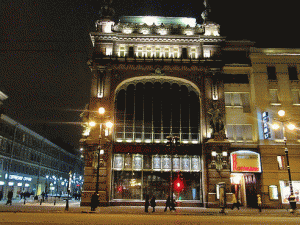
Whenever I travel, I enjoy visiting stores. I don’t particularly enjoy the shopping, I just enjoy the architecture, the history and the decoration of stores around the world. I enjoy window shopping in England – looking at stores with windows that are picturesque – windows comprising many small, interconnected-framed panes found in towns all over the Cotswolds and Cornwall. The most famous of this genre of “Ye Olde Shoppes” is in London – Dickens’ Curiosity Shop (1668).
Some of the world’s top museums were “Green” centuries before that movement. Moreover, some storefronts are so artistic they look as if they belong in museums. And in many major museums, they are: Paris’ Museum Carnavalet preserves ancient storefronts as does New York’s Metropolitan Museum of Art, York’s Castle Museum etc.
Great antique pharmacies are a store type that has survived in cities all over Europe and the USA, including Beaune, Bruges, Dubrovnik, New Orleans, Rome, Salzburg, Strasbourg, Wurzberg and Williamsburg (Virginia).
Another category of elegant, beautiful and historic store is the upscale food emporium. The two most elegant in the world are the Elyseev stores in Russia. St. Petersburg’s Elyseev store on Nevsky Prospect showcases a stunning Art Nouveau interior and exterior. The Moscow Elyseev store is in an 18th-century building with an even more dramatic Art Nouveau interior.
My favorite Art Deco market is Riga’s enclosed market – which used to be a zeppelin hanger. Riga Airport has stores representative from that city’s downtown establishments. Emihls Gustvas chocolate store at Riga Airport is where I had my best hot, thick dark- chocolate drink, which enticed me to duplicate that experience at their downtown store.
Markets that sell many different products under one roof are found in exotic locations such as the Khan El Khalili Bazaar (Cairo). I always visit the Istanbul’s Grand Bazaar, which has some great values for those who wear leather above the ankles. There are also great bazaars in the “old city” of Jerusalem, Damascus and Aleppo. (Hopefully in the near future, you will be able to visit them on the same trip.)
And let’s not forget antique markets, flea markets, night (food) markets in Taipei, Beijing (and other Asian cities) and the unique floating markets of Thailand.
The worlds’ most famous stores hangout on “Main Street” – which the Brits call “High Street.” There’s London’s Bond Street and Knightsbridge Road; Rome’s Via Condotti; Milan’s Via Montenapoleone; Paris’ Rue Faubourg St. Honore; St. Petersburg’s (Russia) Nevsky Prospect; New York’s Fifth Avenue; Beverly Hills’ Rodeo Drive etc.
The first half of the 19th century saw the introduction of the shopping arcade. Among the most famous: London’s Burlington Arcade, Paris’s Galerie Vivienne, Brussels’ St. Hubert, St. Petersburg (Russia) Passage, Prague’s Lucerna Galleria (designed by Vaclav Havel’s grandfather), Naples’ Galleria Umberto, Milan’s Galleria Vittorio Emanuele II, the many arcades in Cardiff (Wales), etc. These were not created to replace main shopping streets – but merely to link them. That’s where they differ from shopping malls.
Shopping streets are usually more historic and tourist friendly than enclosed shopping malls. (Unless you’re in a very humid environment such as Singapore, Kuala Lumpur, Hong Kong, Bangkok, Manila.)
The newest trend in store for stores is the most “Green” application – recycling buildings that had a previous purpose and adapting them to store design – such as railroad stations in St. Louis, Providence, New York’s (Grand Central Station), Washington (Union Station), St. Petersburg (Warsaw Station). And this trend also goes the opposite way: A branch of Paris’ Printemps Department Store became a Holiday Inn. And a New Orleans department store became a Ritz Carlton.
Department store cafeterias are a great way to sightsee the store and they’re reasonably priced. Many department store cafeterias offer unique, spectacular views. Galeries Lafayette’s cafeteria gives a rare bird’s-eye view of the Paris Opera’s rear silhouette. Samaritane’s summer terrace gives you more choices of Paris views than food choices.
Urban downtown department stores define Christmas. Paris’ Printemps and Galeries Lafayette not only decorate their store windows and giant inner, covered Art Nouveau courtyards, they also splashily and electronically light up their facades. My first view of Harrod’s was at Christmas. I loved the lit electric lights emphasizing its ornate Victorian architectural detail. When I returned the next summer, I then realized that it’s lit up every night! What a treat without even buying anything.
No comments:
Post a Comment